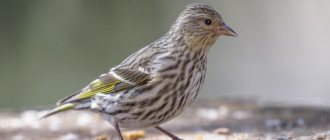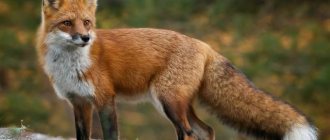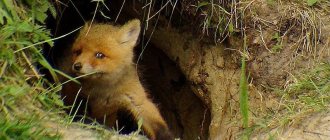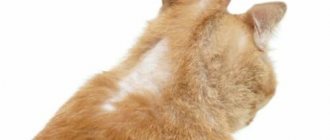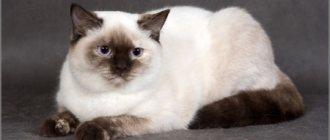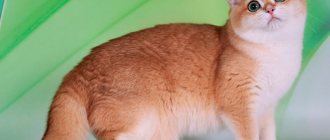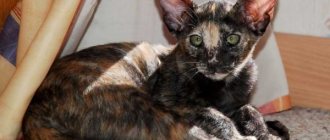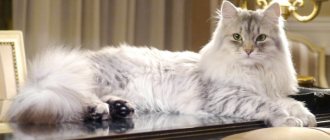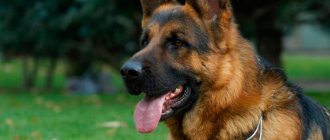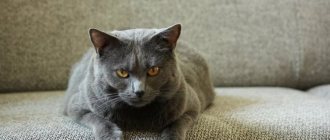The huge Siberian cat, adapted to the harsh climate, lives on the vast territory of the Siberian region of Russia. These owners of the Taiga, together with other animals, adapted to difficult living conditions, learned to get food, catch birds and small animals.
Living with humans, they exhibit hunting instincts and have become assistants in getting rid of rodents. Siberian cats have received recognition as the best rat catchers. These long-haired beauties are smart, have a balanced character and get along well with all family members.
Origin story
There is an opinion that the ancestors of the Siberian cat were Norwegian forest cats, which were brought to the country by settlers. Written sources from the 16th century mention Bukhara cats - large, strong animals with thick hair and an independent character. You can agree with both the first and second versions, as well as refute both. But one thing is known for sure: in 1986, breeders began to select for breeding the so-called “native” Siberian type: large, fluffy and with powerful paws.
Animals fell into their hands simply: local residents brought their own animals to participate in the experiment. Gradually, breeding work began in the Far East and Siberia. In 1991, WCF adopted the standard developed by felinologist Olga Mironova. After 5 years, the breed was recognized by TICA and FIFe.
Currently, there are several large centers for breeding Siberian cats in Russia: in Moscow, St. Petersburg, Saratov, Yekaterinburg, Kirov, Petro was gradually identified as a separate breed.
A kitten without a pedigree costs about 10-20 thousand rubles, with documents - up to 40,000 rubles.
Interesting facts about tabby color
- According to the beliefs of many peoples of the world, tabby cats promise their owners good luck in all endeavors
: from love affairs to financial success; - There is an interesting legend regarding the origin of the name “tabby”
. Allegedly, the name of the color was given in honor of the Attabiya quarter of the Iraqi city of Baghdad, from where in the 17th-18th centuries. fabrics of amazing beauty with unusual moire patterns were supplied to English cities. Some people thought that the stripes on a cat’s fur coat looked like fabric patterns with fancy patterns; - Tabby color is considered the most ancient, natural color
. It was with these characteristic patterns that cats existed in ancient times. But they didn’t need the stripes for beauty, but for camouflage from potential victims and larger predators; - In the popular dream book of Felomena there is an explanation that seeing a striped cat in a dream
means unexpected luck or a date with a wonderful, unusual person; - Many felinologists and cat lovers believe that tabby-colored pets have the best health
. And all thanks to a special gene, which is responsible for the wild striped color, and is also directly related to the animal’s immunity; - All cats with red (red) and cream fur have stripes on their coats
. It’s just that sometimes they are not expressed too brightly, and therefore it seems as if the animal’s color is monochromatic and solid, but this is not so.
Standards
The appearance of the Siberian cat is impressive: its body is powerful, large, covered with thick and long hair. Females weigh 4-5 kg, the weight of an adult cat is much larger - 7-8 kg, and sometimes reaches up to 12! These are real long-livers - sometimes they live up to 20 years.
| Standard | Description |
| Head | Trapezoidal, with smooth lines. There is no clearly defined “stop”. The chin is clearly defined, as are the cheekbones, and the cheeks are round and full. |
| Ears | Wide at the bottom, triangular, with rounded tips. They are slightly inclined forward, pubescent both outside and inside. |
| Eyes | Oval, very expressive. Small, but open. Placed slightly obliquely, widely. Iris color: yellow or green (all shades). |
| Torso | Massive, with a wide back and a strong rear. The chest is voluminous, the neck is muscular and short. The paws are thick, of medium length, with well-developed muscles. The paws are round and wide, flattened. The fur grows in tufts between the toes. |
| Tail | Long and shaggy, tapering towards the tip. |
| Wool | The coat is very dense. The undercoat is very soft and delicate to the touch (due to the fact that the texture of the hairs is thin). The top layer of wool is stiffer, grows evenly, and in the area of the sides and tail seems to “fall” down. Siberian wool repels moisture well. By winter, the “fur coat” becomes thicker and shinier, especially in the area of the “collar” and “panties” on the hind legs. |
Significant disadvantages of the breed:
- “Bare” fingers;
- Coat growing in tufts and dull, lack of undercoat;
- Tail with bald spots, short or too long;
- Eyes that are too big or small;
- Ears too small or large;
- Flat cheeks, elongated muzzle, long thin neck, poorly developed bones.
Description of the breed
Thanks to its luxurious long-haired fur coat, the Siberian cat looks like a true gentleman. They have a large appearance, a pretty face with a luxurious frill-type collar.
All the appearance features and characteristics of the Siberian cat breed are reflected in the table.
Table No.1 Description of the breed
| Siberian cat. Country of origin: Russia, year of recognition: 1987. | ||
| External data | Description | Note |
| Body, body, chest | The dimensions of the body are emphasized by the massiveness of the muscular body, which has a proportional, straight back of medium length. The neck is short and rests on the voluminous massive chest. | The overall appearance of the torso makes a powerful impression. |
| Paws, limbs | The limbs are of medium length, with the hind legs longer than the front ones and ending in large paws. | Between the toe pads are tufts of thick fur. |
| Tail | Medium length, wide at the base and tapering to a rounded end. | Fluffy, like a fox's tail, the real pride of a Siberian cat. |
| Head, muzzle | It has the shape of a trapezoid, narrower at the bottom. The nose with a slight curvature smoothly blends into the forehead. The muzzle has a rounded outline with full cheeks and a pronounced chin. | The appearance of forest cats was formed thanks to the severe Siberian frosts. |
| Eyes | The large eyes are set wide apart and have an oval teardrop shape. The look is intelligent, expresses curiosity and seriousness. | Eye color is green or yellow-amber. |
| Ears | The ears can be medium or large, slightly rounded and tilted forward. medium to large ears are round in shape and slightly tilted forward. The inside of the ear is covered with short hair. | The tips of the ears may have tufts, like those of a lynx. |
| Wool | Siberian cats are a long-haired breed. The winter coat is much longer than the summer coat. There are “pants” on the hind legs. There is a fluffy collar on the neck. The undercoat is denser than the coarse outer coat. | The top coat has water-repellent properties, this property helps in severe frosts. |
| Average height at withers | Approximately 35-40 cm | |
| Average weight | ||
| Average weight of females | from 3.5 to 7 kg. | The average weight of a female is significantly less than |
| Average weight of males | from 6 to 9 kg | |
| average life expectancy | 16-20 years old | Long-term residents with good care live up to 25 years |
Colors
Popular colors of the Siberian breed include both solid colors and various patterns. The table shows the colors that are most common.
Table No. 2 Popular colors of the Siberian cat breed.
| Color type | View | Description of the species | Application |
| Plain (solid) | Black | Intense monochrome color, all hairs are evenly colored from root to tip. | Rare black Siberian cat. Black pigment presented. |
| Red (red) | Yellow pigment present. | ||
| Clarified solid | blue | The Siberian blue cat is especially prized. | |
| cream | A light, delicate shade is preferred. | ||
| Neva Masquerade | Color point: | A separate breed with blue eyes has been identified. | It has not received recognition in all international associations. |
| Multicolored | Tortoiseshell color | A combination of spots of white with evenly distributed spots of black and red or blue and cream shades. | Tricolored females are more common than males, which are usually sterile. |
| Tabby (wild) | Marble | alternation of dark and light pigments in a certain pattern. | Widespread colors. Forms patterns and designs on wool |
| brindle | A combination of dark and light stripes. | ||
| Spotted | there are small snow-white spots. | ||
| Chinchilla These are very rare and valuable colors | Smoky | The uncolored white base of the hairs is combined with a colored tip. | Smooth color without patterns |
| Silver | Consists of 2 stripes, light at the very base and dark at the tips. | They do not have a clearly defined pattern. | |
| Gold | The ends of the hair are colored apricot. | ||
| Basic white | Pure white | Beautiful, solid, intense white color. | Very rare |
| Bicolor | the triangle on the muzzle goes down smoothly from the bridge of the nose to the chest, onto the stomach. The inside of the limbs is also white. | From 1/3 to 2/3 of the total coat is white | |
| Harlequin | tail and spots on head, back and legs | 2/3 -5/6 of the coat remains white. | |
| Wang | Only the tail and 2 spots on the head are colored | 90% white. | |
| Unacceptable colors. | · lilac, · faun, · chocolate, · cinnamon, · cinnamon. | Have not received recognition in all international associations. | They are treated according to the standard of marriage. |
Colors
- Solid: red, black, cream, blue.
- Tortoiseshell: when one shade is superimposed on another. For example, blue to cream, black to red.
- Tabby: “wild” color. Light and dark stripes, spots and areas alternate on the body, forming a pattern. The 3 most common are spotted, marbled and brindle.
- Golden and silver. They are quite rare.
In the photo there are cats of the Siberian breed of colors: tortoiseshell, tabby, golden.
White Siberian cats are even less common. There are 4 types: harlequin (with specks on the paws, back and head); bicolor (there is a dark triangle on the stomach, chest, inside of the paws and muzzle); spotted (there are several white areas on the body) and van (white except for the tail and a couple of areas on the top of the head).
Disqualifying Faults
In addition to the reasons common to representatives of all breeds (non-conformity, color falsification, unkempt appearance, signs of disease, the presence of parasites, aggressiveness, oligo- and polydactyly, cryptorchidism in cats, tail defects)
The grounds for disqualifying a Siberian cat are:
- pronounced signs of the Persian type;
- deafness of cats and white cats (according to the rules of European rings);
- umbilical and inguinal hernias (Neva masquerade hernias are susceptible to their occurrence).
This is interesting! However, situations where Siberian cats are deprived of an exhibition rating are quite rare: high standard qualities and good health are signs reinforced by the professional, serious work of Russian felinologists.
Return to content
Character and behavior
The Siberian cat, despite its great weight and apparent massiveness, is a very agile, jumping and fast creature. At a young age, he will not miss the opportunity to be pampered; as he matures, he becomes more sedate, but not lazy. The sense of self-esteem of these furry egg-bottles is “overflowing,” so don’t expect that the cat can be squeezed and stroked whenever you want. If the “Siberian” is in a good mood, he himself will ask you for a portion of affection, but if the cat is not in a good mood, it is better not to bother him - he begins to snap back and may even give you a paw.
He has a subtle instinct: if the owner has problems, he will never impose himself, but will sit on the sidelines and wait for the right moment.
Of all the family members, he chooses one “leader” for himself, and perceives the rest as his personal servants. He will faithfully wait for his owner from work, sleep on his things, meet him at the door and cuddle. They don't like loneliness. A Siberian cat definitely needs personal toys and its own closed house, where it can hide and relax from others.
Treats guests condescendingly. He quickly finds a common language with pets, but prefers to maintain neutrality: he is unlikely to sleep side by side with another cat or dog.
Name the cat who always wanted to live together
BasilioLeopold
It takes root well both in an apartment and in a private house. The last option is better: Siberian cats need walks in the fresh air, love to climb trees and bushes, and hunt for birds and moles. Without physical activity, she will feel “out of place,” so take her for walks more often, and put up a special complex at home with ladders and shelves.
Excellent hunters: from an early age they fearlessly hunt insects, mice and birds. Therefore, it is not worth having either one or the other in the apartment.
They adore small children: they know how to babysit them, try to protect them from strangers, play and indulge with them. At the same time, the claws never extend, do not hiss or snort, even if the child hurts the cat.
He quickly remembers his name and the commands “eat”, “drink”, “play”, “walk”. There are no problems with the tray.
This breed often develops hyperexcitability as it ages. And, unfortunately, the main activity occurs at night, when people want to sleep.
Care instructions
Do not let your Siberian cat bask in the sun for a long time: from the bright sun, its fur begins to fade and may change color.
Wool
The calling card of the “Siberian” is its thick and long coat. It is necessary to comb the animal 2-3 times a week, during the molting period - daily, first using a wide-toothed comb, and then a slicker brush.
Bathing
“Siberians” are bathed only when their fur gets dirty: they don’t like water. The exception is an exhibition, before which a general polish is put in place.
Shampoos are selected that are special, do not dry out the coat and skin, and contain antibacterial additives. For example, “Detangling Celandine” Ecoprom, Doctor ZOO for long-haired cats, Phytoelite “From tangles”, AVZ Elite Professional.
Claws
The cat's claws are trimmed once a month: no more than a third, and without touching living tissue. The rest of the time, the animal copes on its own, grinding them off on a scratching post.
Ears
Check your ears every week. Accumulations of sulfur and dirt are removed with a cotton swab dipped in lotion (Api-San “Rosinka”) or chamomile decoction. The eyes of Siberians do not require special care.
Teeth
Once a week, be sure to brush your cat's teeth using a special short-bristled brush and cat toothpaste. If the animal refuses to be cleaned, scratches or becomes very frightened, use alternative means: liquid gel (dropped into water) or cleaning pads.
In the photo there are kittens of the Siberian breed
Interesting facts about the breed
- The cat of the Siberian breed Dorofey, who belonged to D.A., became famous. Medvedev. He was a participant in a popular television show.
- Siberian cats are considered the best rat catchers; not a single rodent can escape the clutches of a Siberian.
- The Siberian cat is naturally formed by nature and with all its huge appearance shows power and health.
- In Tyumen Park there is a “Square of Siberian Cats” in the form of 12 cast iron figures painted with golden paint. They were installed in honor of the cats who, during the Second World War, saved the collections of the Leningrad Hermitage from an invasion of rats.
Catering
If you feed an animal based only on its tastes - for example, only meat or fish - sooner or later its metabolism will be disrupted, problems with its kidneys, fur and teeth will arise. Therefore, remember the following rules:
- A healthy Siberian cat is fed 2 times a day: morning and evening. Serving size: 30-60 g per kg weight). A pregnant, lactating individual, with chronic diseases or an old one can be fed 3 times, or the portions can be increased.
- In addition to food and water, they grow grass (you can buy it at a pet store). The animal will come to her when he wants. The weed helps cleanse the stomach and is also an additional source of folic acid, vitamins and fiber.
Natural products
What is included in the diet if you choose natural food.
- Meat - all varieties: streaky beef, lean lamb, rabbit, turkey, veal, lamb. The meat is pre-frozen, and before feeding, it is doused with boiling water and cut (or minced). It is better to boil chicken. Bones, tripe and skin are not given; lard, duck and goose meat, and pork are also prohibited.
- Offal: heart (boiled), liver (stewed or boiled), kidneys and lungs (boiled), udder (a little fatty, so you can give it occasionally).
- Fish - sea varieties. These are flounder, tuna, hake, trout, cod, salmon. Raw fish causes intestinal upset and negatively affects the appearance, so the product is boiled or stewed. Fatty varieties - herring, mackerel, sprat - can be given rarely. Canned fish from pollock and cod - little by little and as a delicacy.
- Chicken eggs - boiled and only the yolk. Raw eggs are poorly digested by Siberians. Quails can be given whole.
- Dairy products: cottage cheese (with whey or egg yolk), fermented baked milk, sour cream, Varenets, natural yogurt, unleavened cheese. Products with dyes and pieces of fruit are prohibited. Whole cow's milk is given only if the cat does not have a negative reaction to it: diarrhea or vomiting.
- Vegetables: beets, carrots, pumpkin, green peas, cabbage (kohlrabi, cauliflower and white cabbage), some gourmets like to nibble on cucumbers and tomatoes. Vegetables are stewed and added to the porridge, rubbed with vegetable or olive oil.
- Cereals: oatmeal, rice, buckwheat, barley, pearl barley. Porridge is cooked in water or diluted milk, without sugar or salt.
- Fruits are not a necessity, but are allowed as a treat. Treat your pet to a piece of melon or apple or strawberry.
- Greens: parsley, dill, green salad, fresh nettle scalded with boiling water.
- Rye bread – a small piece once a week is enough. Bone meal is given if the cat refuses dairy products.
You cannot give:
- Dog food;
- Human vitamins;
- Sweet, smoked, salty, baked goods, flour;
- Tea, coffee, sparkling and mineral water, coffee, juices, alcohol;
- Eggplants, grapes, citrus fruits, legumes.
A piece of sugar-free cookie can be given as a reward, for example, during training.
Expert opinion
Dusheba Vera Ivanovna
In 2010, she graduated from the Moscow State Academy of Veterinary Medicine named after K.I. Scriabin with honors, specializing in veterinary medicine. I regularly attend veterinary conferences, congresses, and webinars.
Choose bowls for water and food that are shallow and stable. If you feed your cat natural food, you should wash the dishes after each meal. After dry food - once a week. Water should be freely available, clean and at a comfortable warm temperature. You can't pour from the tap! Give your cat bottled water or use tap water at home. If there is no fresh water in the bowl, the “Siberian” will climb into the toilet or try to open the tap on its own.
Recommended food
Industrial prepared food is divided into 4 groups.
Economy class food is the cheapest, but also the most stupid. Made from food waste, they contain a small amount of vitamins. TerraCat, Friskies, Perfect Fit.
Premium food is somewhat of a higher quality, but the percentage of meat is low, and the vitamins and minerals are not enough for the animal to fully exist. Mnyams, Night Hunter, Native food.
Super-premium and holistic food is made from high-quality products and contains the necessary minerals and vitamins for the growth and development of the animal. But such food is not cheap. Examples: super-premium - Brit Care, Leonardo, Vet Life; holistic - Jaguar, Nutram, Naturea.
Below are recommended super-premium foods. Links with the names of the food are clickable, on them you can, within our website, get acquainted with the descriptions of the food and read reviews from the owners of the Siberian cat breed.
| Holistic | Super premium | Premium |
| Acana | Brooksfield | Royal Canin |
Diseases
The Siberian cat has a strong immune system, but this breed also has a number of problems. Most, fortunately, can be dealt with, you just need to seek help in time.
- Periodontal disease is a common disease among Siberians. The reason is the distant crossing of the forest Siberian breed with the Himalayan and Persian cats to consolidate physical characteristics. The provoking factor is poor nutrition and poor oral hygiene control by the animal owners. Damaged teeth have to be pulled out.
- Oncology – occurs in Siberian cats with white fur. With timely diagnosis and treatment, the animal lives quite a long time.
- Polycystic kidney disease is diagnosed in older cats. Cysts begin to grow, which gradually fill with fluid and negatively affect the functioning of the kidneys. There are no preventive measures, so animals with poor heredity should not be bred.
- Kidney stones and other pathologies of the lower urinary tract. Almost all are treatable.
- Hypertrophic cardiomyopathy is a thickening of the heart muscle. In Siberian cats, even kittens suffer from the disease (in other breeds, the disease manifests itself in old age). It cannot be cured, but early diagnosis and supportive therapy can prolong the cat’s life for many years.
If your pet begins to hide in corners, eats poorly, behaves restlessly, or vice versa - moves little, vomits or blood is found in its feces - immediately take the cat to the veterinarian!
Expert opinion
Dusheba Vera Ivanovna
In 2010, she graduated from the Moscow State Academy of Veterinary Medicine named after K.I. Scriabin with honors, specializing in veterinary medicine. I regularly attend veterinary conferences, congresses, and webinars.
Do not ignore vaccinations, even if your pet lives in an apartment and does not come into contact with other animals. The causative agents of plague, chlamydia, viral rhinotracheitis and the like can be brought into your home very simply: on your shoes or clothing, on your hands and other objects. The first vaccinations are given to babies at 3 months, they are first given an anthelmintic drug (7-10 days before the procedure), and revaccination is done a month after the first vaccination. Keep in mind that this is a burden for a small organism, so if your pet is sick, or his teeth are changing, or he needs to be transported to a place with a different climate, postpone vaccination for a while.
In the photo there is a Siberian cat on a walk


